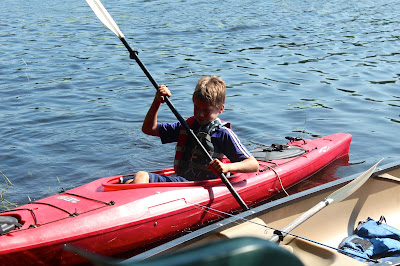Goldenrods are members of the Asteraceae, or aster, family, meaning their "flowers" are really composed of many flowers working together to create a flower-like inflorescence that attracts pollinators. Other flowers in this family include sunflowers, daisies, fleabanes, zinnias, dandelions, hawkweeds, chrysanthemums. If you have any of these flowers handy, you might take it apart and study it up close. Many, like the daisy or sunflower, have both ray and disk flowers. The rays are the "petals" and the disk flowers cluster to make the center circular shape. Others only have one or the other (e.g., dandelions have only ray flowers). Goldenrods have both, but each inflorescence, or capitula, is very small, so it's harder to see the "sunflower" shape with the naked eye.
I only had time to i.d. two goldenrods this weekend (no, that's not true; I had plenty of time to pick and i.d. flowers on Saturday, but I spent the whole afternoon lying in the hammock, reading. Seventy-nine degrees, sunny, breezy, no bugs--we don't get many days like that in a year and it would be a shame to waste one being productive). This first one has been driving me crazy all summer:
Things to look for when identifying a goldenrod are the arrangement of the leaves (are they basally disposed--with rosettes of basal leaves--or all stem leaves? Do the leaves decrease dramatically in size moving up the stem or are they roughly the same size?) and the flowers (does the capitulescence--the cluster of capitula--nod? Do all of the capitula growing in a single plane--secund--or are the stems upright with the capitula arranged around the stem?).
This goldenrod has basally disposed leaves and upright, non-secung capitulescence, with slightly hairy leaves and stem. But the flower I kept identifying it as doesn't grow north of Connecticut.
And then I looked at it through the hand lens. The ray flowers, which I had been certain were pale yellow, were actually white! This made for an easy i.d. of white goldenrod (Solidago bicolor).
The second goldenrod I identified grows quite commonly along the edge of our driveway and in our fields. The flowers on many of the plants are already going by, but I found a few specimens still in their prime.
Other things to look for with goldenrod include whether or not it grows in a crowd (colonial), the texture of the stem and leaves (smooth or hairy?), the shape and edge of the leaf (toothed or entire?), and whether there is one prominent central vein or three.
This specimen was growing fairly alone, but looked like a much smaller version of the goldenrods growing in a nearby colony (but whose flowers had already gone brown). In other ways it was very similar--tiny capitula (as you can see in the next photo with my pen tip for scale), rough, toothed leaves arranged in kind of a spiral around the stem, hairy stem, secund capitulescence.
You can see the hairy stem of this specimen in the next photo.

And the stems of the larger specimens in the next.
These are the capitula of the larger plants. I'm going with rough goldenrod (Solidago rugosa) for both my specimen and its larger neighbors. Go Botany declares this species highly variable, and I think the differences between my smaller specimen and the larger plants in the colony fall within the range of natural variation, and may be due to my plant's size or relative age.
After investigating these two goldenrods, I cam across a flock of turkeys in the neighbor's field. Unfortunately I only had my phone with me (to take the close-ups with my macro rubber band), so it's not a great photo, but a wild one. I love the little turkeylets that can be seen waddling after their mothers this time of year.

And when I went back out a couple of days later to get whole-plant shots with the real camera (the phone really does a poor job on those), I had a little face-to-face with this guy in my pin oak. He clacked his teeth together to let me know he wasn't pleased to have his photo taken.
What's wild in your neck of the woods?


























































